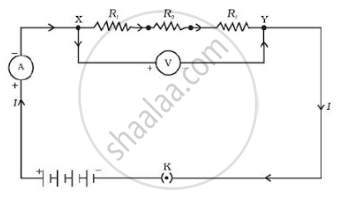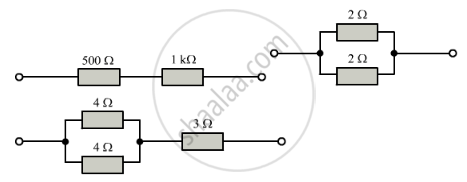Advertisements
Advertisements
Question
When do you say that the resistors are connected in this way? Draw a circuit diagram.
Solution
Resistors connected in series: - If the number of resistance are connected one after another in such a way that the same current flows through each resistance, then the arrangement is called resistance in series.

Let R1, R2, and R3 are three resistances connected in a series combination and let be their effective resistance in the circuit.
Let V1, V2, and V3 be the P.D. across resistances R1, R2, and R3 respectively. Let ‘V’ be the P.D. of the cell. Let ‘I’ be the current flow through each resistance.
According to Ohm’s Law,
Conclusion:
If the resistors are connected in series then.
- In a circuit, the current is the same in every part of the circuit.
- The resistance of the combination of resistors is equal to the sum of the individual resistors.
- The total voltage across the combination is equal to the sum of the voltage drop across the separate resistors.
- The effective resistance in a series combination is greater than the individual resistances.
- This combination is used to increase resistance in a circuit.
APPEARS IN
RELATED QUESTIONS
A piece of wire of resistance R is cut into five equal parts. These parts are then connected in parallel. If the equivalent resistance of this combination is R’, then the ratio `"R"/"R'"` is ______.
Write any two characteristics of a series combination of resistors.
Give one example to show how the resistance depends on the nature of material of the conductor.
Calculate the resistance of an aluminium cable of length 10 km and diameter 2.0 mm if the resistivity of aluminium is 27 × 10−8 Ωm.
Give the law of combination of resistances in series.
V = IRTwo resistances X and Y are connected turn by turn : (i) in parallel, and (ii) series. In which case the resultant resistance will be less than either of the individual resistances?R = R1+ R2+ R3
Calculate the combined resistance in each case:

A p.d. of 4 V is applied to two resistors of 6 Ω and 2 Ω connected in series. Calculate:
(a) the combined resistance
(b) the current flowing
(c) the p.d. across the 6 Ω resistor
The diagram below shows part of a circuit:

If this arrangement of three resistors was to be replaced by a single resistor, its resistance should be:
(a) 9 Ω
(b) 4 Ω
(c) 6 Ω
(d) 18 Ω
You are supplied with a number of 100 Ω resistors. How could you combine some of these resistors to make a 250 Ω resistor?
Choose the correct option from given alternative:
Two bulbs of 100 W and 40 W are connected in series. The current through the 100 W bulb is 1A. The current through the 40W bulb will be:
State the effect of rise in temperature on the resistance of semi-conductors.
How does the resistivity of an alloy such as constantace depends on temperature.
State expression for Resistance connected in series.
Three resistors of 6Ω, 3Ω and 2Ω are connected together so that their total resistance is greater than 6Ω but less than 8Ω Draw a diagram to show this arrangement and calculate its total resistance.
In the circuit shown below, calculate the equivalent resistance between the points (i) A and B, (ii) C and D.
What is the equivalent resistance between the points X and Y for the given network?
2Ω resistor A, 1Ω resistor B and 4Ω resistor C are connected in parallel. The combination is connected across a 2V battery of negligible resistance. Draw the diagram of the arrangement and calculate:
(i) The current in each resistor A and C,
(ii) The current through battery.
Two resistors of 4Ω and 6Ω are connected in parallel to a cell to draw 0.5 A current from the cell.
Draw a labelled circuit diagram showing the above arrangement.
